Several species of grouse inhabit my backyard (Wrangell/St. Elias National Park and Preserve), Alaska. Above, sharp-tailed grouse.
video link below: Grouse in my backyard

Several species of grouse inhabit my backyard (Wrangell/St. Elias National Park and Preserve), Alaska. Above, sharp-tailed grouse.
video link below: Grouse in my backyard
Check out my owl photos in June/July 2025 RANGER RICK by clicking link below.
 A pair of gray jays have finished their nest by early April.
A pair of gray jays have finished their nest by early April.
I first saw the gray jays as they flew across the road in front of me. They both carried loads of building materials in their bills. The next day I went searching for their nest. It was rather easy to find as they were both busy with construction. The nest was about twenty feet high in a medium-sized black spruce. They had completed a loose bowl of dry spruce twigs and were currently engaged with stuffing this framework with insulation. The pair gathered black, grizzly hair lichens as well as spruce grouse feathers. But their most prized finds were the long soft plumes of the northern hawk owl. After delivering a load of insulation, the birds would hop into the nest and push with bills and feet as they rotated around in the nest, fitting and forming it to just the right shape. The female begins sitting on the nest and a week later her clutch of spotted eggs is complete. The pair is quiet at the nest site and does not attract attention of those nest raiders, magpies and ravens. When a red squirrel was spotted nearby it was dive-bombed by the male gray jay and driven away.
The female begins sitting on the nest and a week later her clutch of spotted eggs is complete. The pair is quiet at the nest site and does not attract attention of those nest raiders, magpies and ravens. When a red squirrel was spotted nearby it was dive-bombed by the male gray jay and driven away.
 For nearly three weeks the female incubated her four eggs. A few times a day she will leave the nest but only for a few minutes, perhaps to drink.
For nearly three weeks the female incubated her four eggs. A few times a day she will leave the nest but only for a few minutes, perhaps to drink.
 The male gray jay shows up at the nest about once an hour or so to feed his mate.
The male gray jay shows up at the nest about once an hour or so to feed his mate.
 Laying eggs is an energy drain and the female spends hours sleeping.
Laying eggs is an energy drain and the female spends hours sleeping.
 Early nesting grays jays must be able to handle cold, wet conditions in their Alaskan habitat.
Early nesting grays jays must be able to handle cold, wet conditions in their Alaskan habitat.
 Both adults help feed the quickly growing gray jay chicks. Gray jays store amazing amounts of food including carrion and I wondered if they would feed their cached supplies to their chicks. But Instead they foraged the ground for insects and larva, much better food for the new chicks.
Both adults help feed the quickly growing gray jay chicks. Gray jays store amazing amounts of food including carrion and I wondered if they would feed their cached supplies to their chicks. But Instead they foraged the ground for insects and larva, much better food for the new chicks.
 As the chicks grew the gray jays cached stores of carrion became more important. And it quickly became apparent that the nest would never hold four growing chicks for long. By the time the chicks were about two weeks old, they jostle for the best position at the nest. I witnessed deliberate attempts by the larger chicks to force their smaller siblings out. One morning there were just two chicks left in the nest. Below the nest on the ground were the missing chicks, both dead. From human eyes, a tragic event. But for nature, another one of those mysteries of survival.
As the chicks grew the gray jays cached stores of carrion became more important. And it quickly became apparent that the nest would never hold four growing chicks for long. By the time the chicks were about two weeks old, they jostle for the best position at the nest. I witnessed deliberate attempts by the larger chicks to force their smaller siblings out. One morning there were just two chicks left in the nest. Below the nest on the ground were the missing chicks, both dead. From human eyes, a tragic event. But for nature, another one of those mysteries of survival.
Come July of this year the name of the gray jay will change once again. They will officially be known as the Canada jay. And like camp robber and whiskey jack, gray jay will be just another nickname used to describe this gray-colored jay of the northern forests.
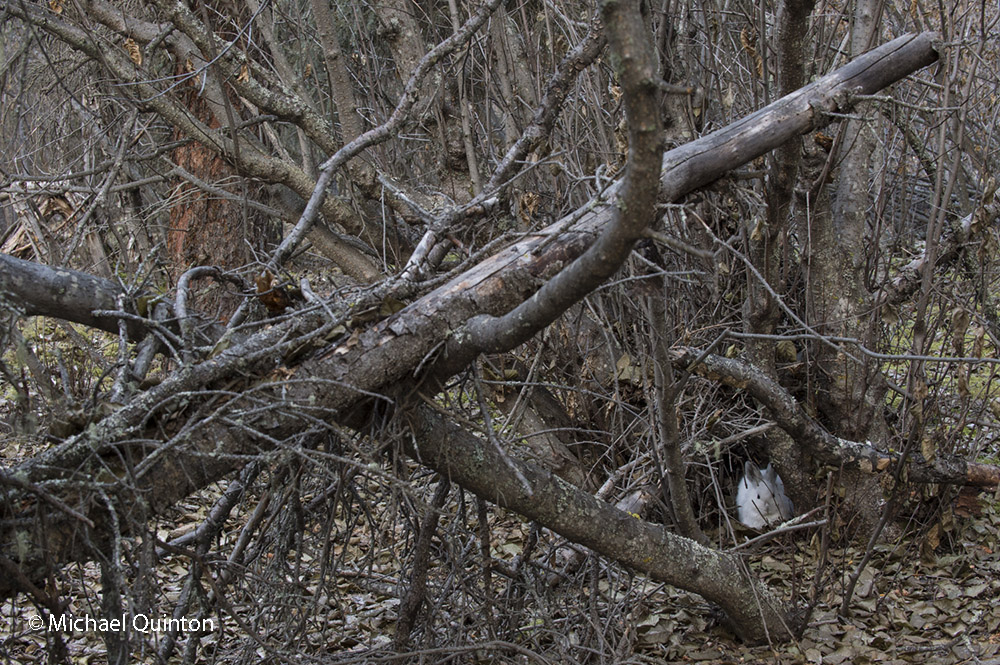 Winter seems to come later and later these past few years. And when that happens the local snowshoe hares are left feeling a bit conspicuous against their drab brown and gray habitat. The snowshoe hares count on their turn coats (brown in summer and white in winter) to help them hide from a gauntlet of predators like lynx, marten, red fox, northern goshawk, great hornedowls to name just a few.
Winter seems to come later and later these past few years. And when that happens the local snowshoe hares are left feeling a bit conspicuous against their drab brown and gray habitat. The snowshoe hares count on their turn coats (brown in summer and white in winter) to help them hide from a gauntlet of predators like lynx, marten, red fox, northern goshawk, great hornedowls to name just a few.
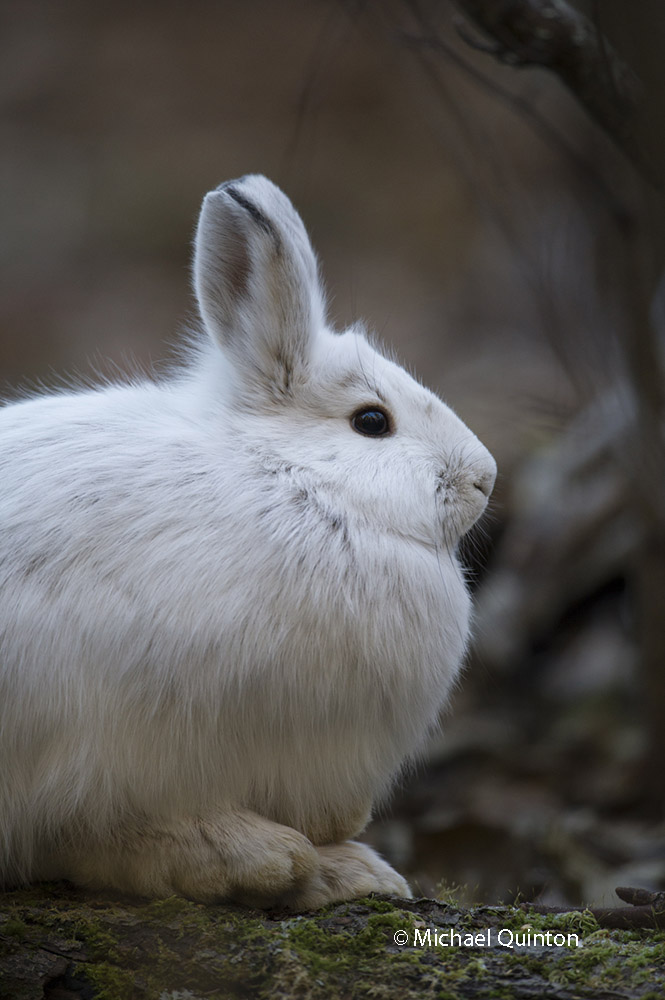 Normally shy, snowshoe hares may tire of dodging my efforts to photograph them after a few attempts and eventually allow me a few close-up shots.
Normally shy, snowshoe hares may tire of dodging my efforts to photograph them after a few attempts and eventually allow me a few close-up shots. 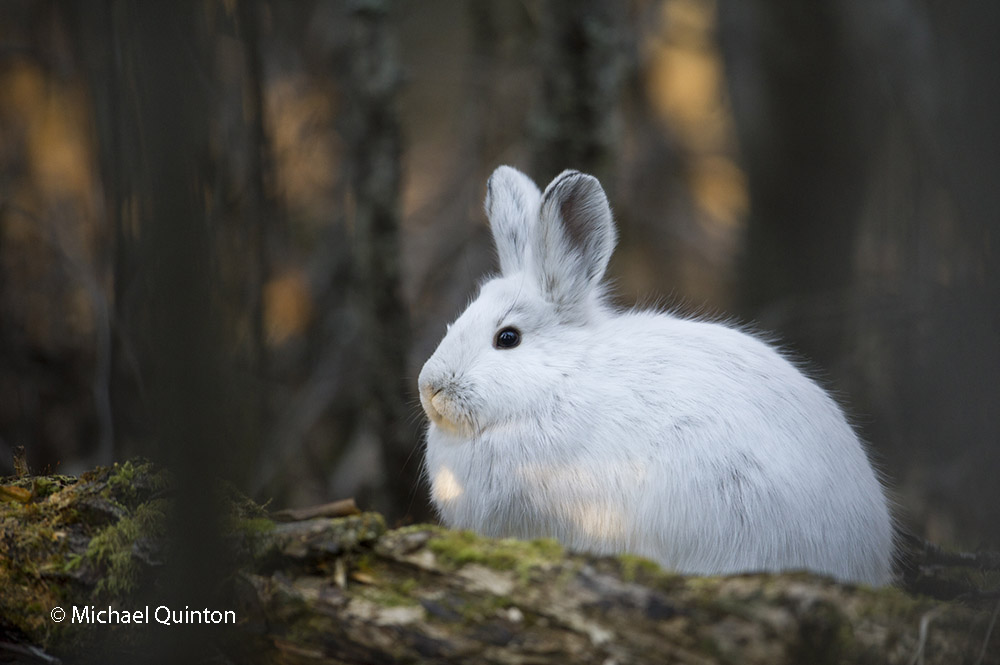 But days of white snowshoes in their snowless habitat are numbered. Snow is inevitable and soon they will be hiding in plain sight just as nature intended,
But days of white snowshoes in their snowless habitat are numbered. Snow is inevitable and soon they will be hiding in plain sight just as nature intended,
A pair of northern hawk owls check out the view from atop a prospective nesting cavity. Hawk owls, like other owls, do not build a nest but use natural cavities and bowled out snags. The male establishes a territory that includes potential nests sites, but it seems to be the female who makes the final choice of snags.
After settling on another snag, the female incubates her eggs. Hawk owls nest early, usually in late April and will endure winter conditions.
Check out my photo story about northern hawk owls in the May 2018 issue of RANGER RICK, Just click the link below.
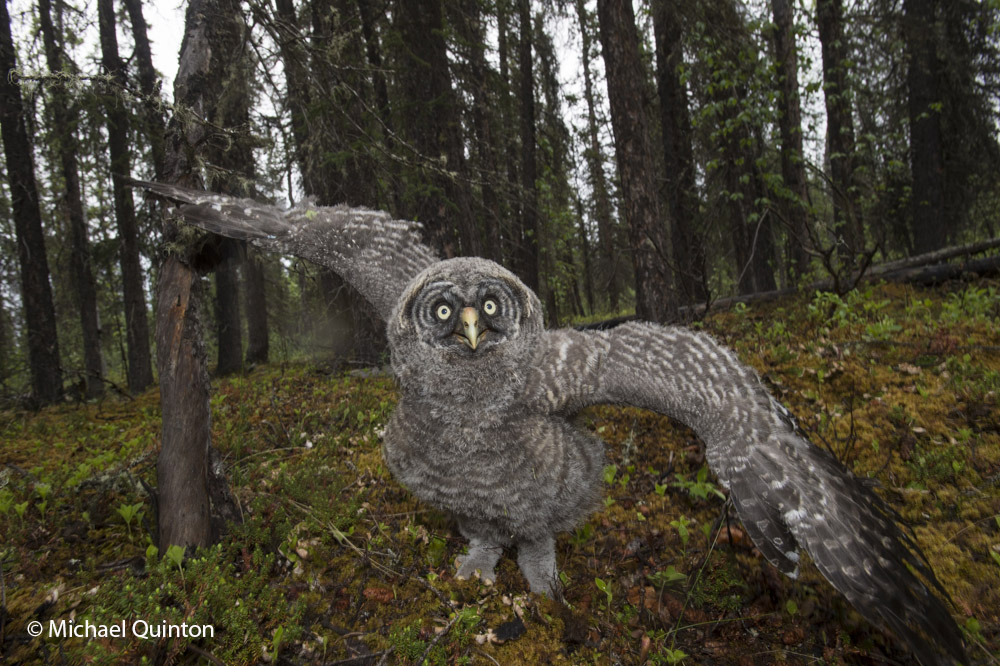 At nearly four weeks a fledged great gray owlet has jumped from its nest to the forest floor. Free from the confines of the nest, (I too am finally freed from the solitary confinement of my photo blind) the owlet walks and leaps to a place to perch.
At nearly four weeks a fledged great gray owlet has jumped from its nest to the forest floor. Free from the confines of the nest, (I too am finally freed from the solitary confinement of my photo blind) the owlet walks and leaps to a place to perch.
Fledged owlets move about fifty to a hundred feet every day, picking out a slanting tree to climb. The ground is a dangerous place for the young, flightless owls. The mobile owl family becomes more difficult to locate by the day.
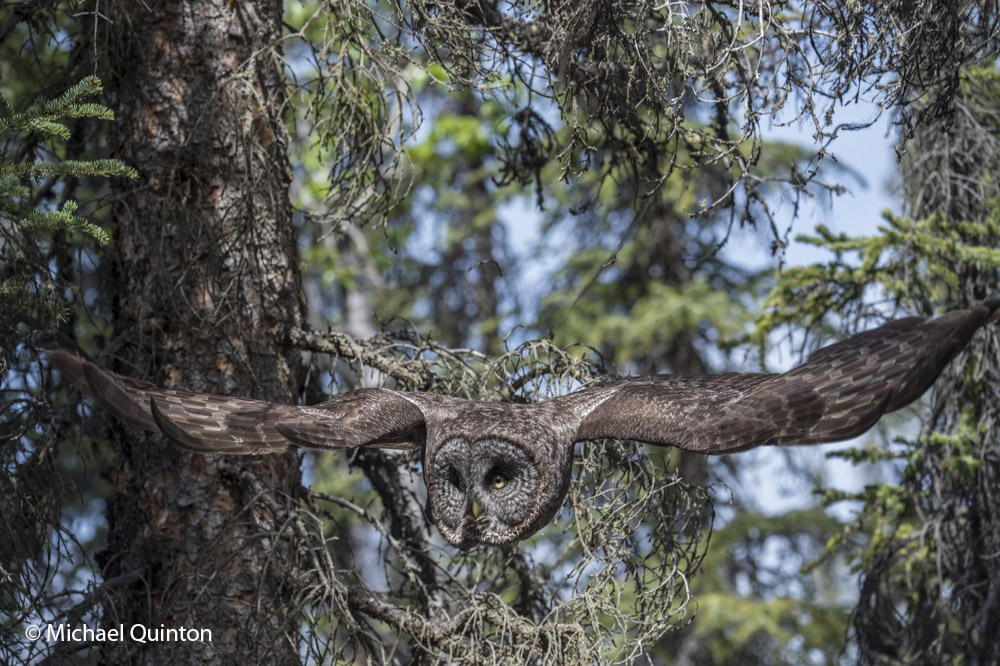 Adults continue to care for their owlets. The female (above), usually staying near the owlets, will do some hunting when an opportunity presents itself.
Adults continue to care for their owlets. The female (above), usually staying near the owlets, will do some hunting when an opportunity presents itself.
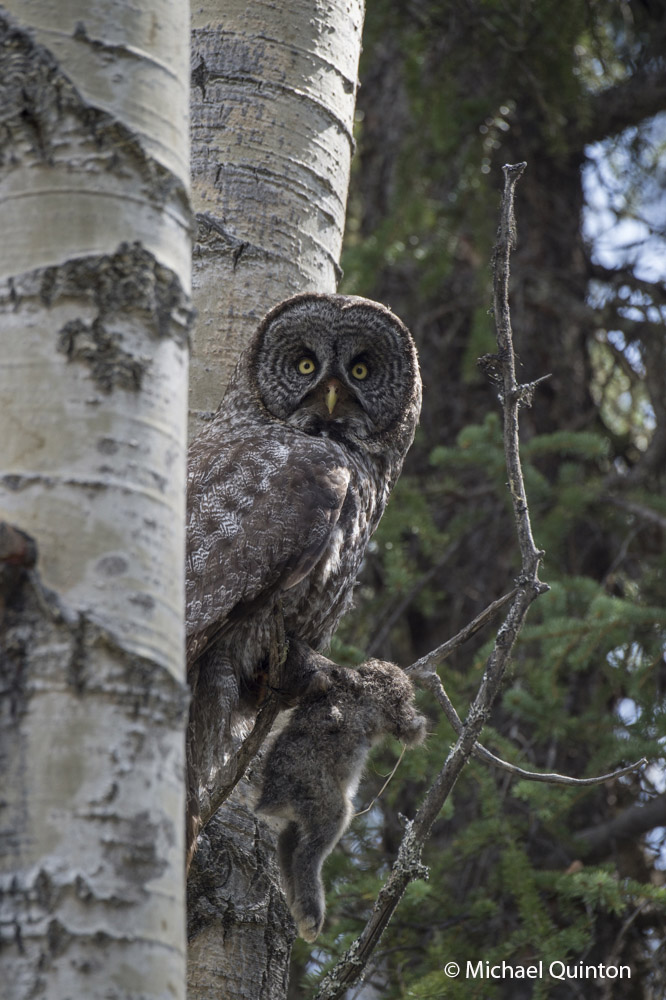 The female with a young snowshoe hare delivered by her mate.
The female with a young snowshoe hare delivered by her mate.
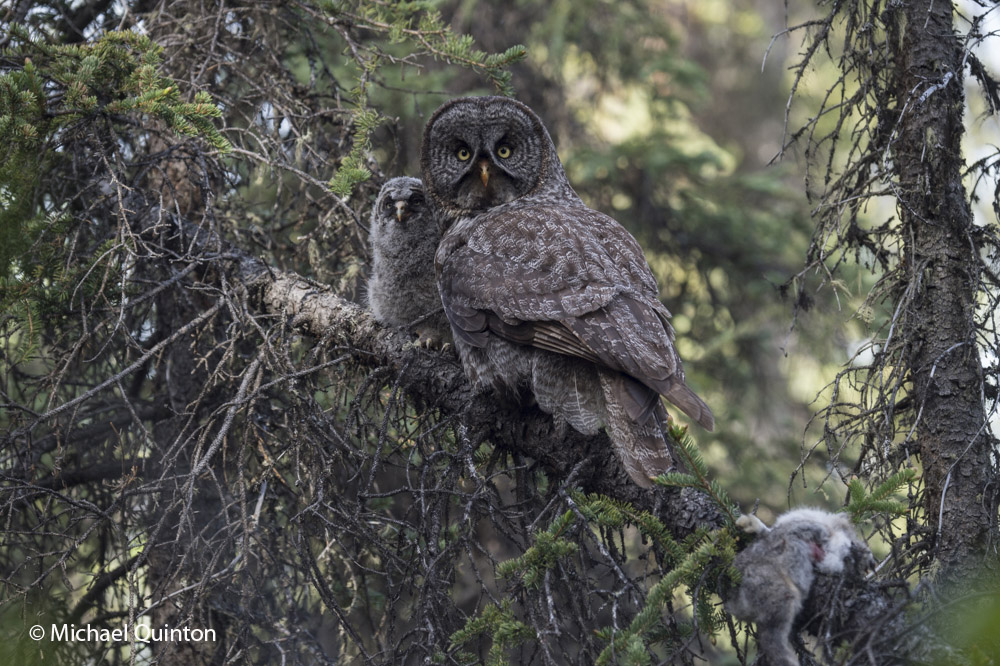 The snowshoe hare, large prey for a great gray owl, will feed her and her owlets for a day. The prey is cached on the ground between feedings.
The snowshoe hare, large prey for a great gray owl, will feed her and her owlets for a day. The prey is cached on the ground between feedings.
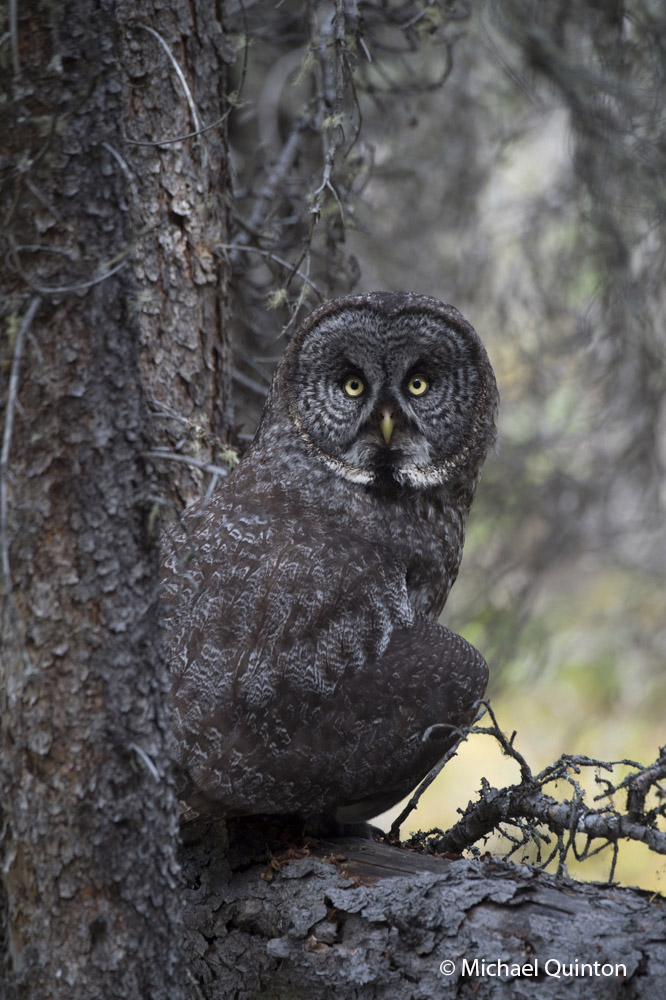 Female perches on log after caching the snowshoe hare.
Female perches on log after caching the snowshoe hare.
Adult female drinking.
 Regurgitated great gray owl pellets and white spruce cones on a bed of sphagnum moss below an owlets perch.
Regurgitated great gray owl pellets and white spruce cones on a bed of sphagnum moss below an owlets perch.
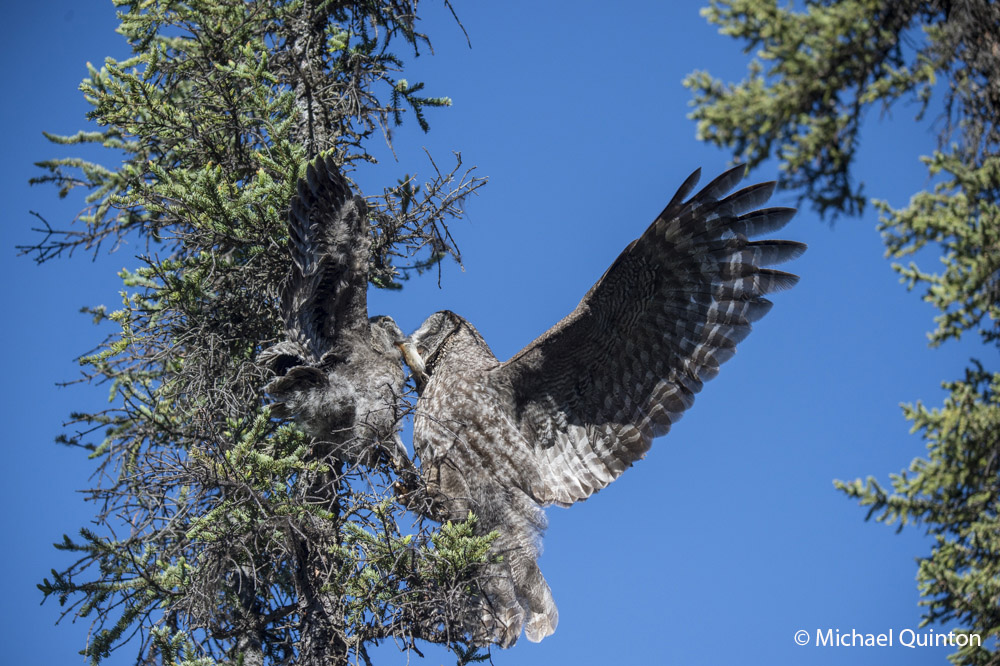 Female delivers her owlet a freshly caught red-backed vole. Fledged owlets swallow voles whole.
Female delivers her owlet a freshly caught red-backed vole. Fledged owlets swallow voles whole.
 A tough job but it must be done.
A tough job but it must be done.
Female great gray owl holds another red-backed vole just delivered by her mate. The well fed owlets are not hungry at the moment so the vole will be placed in the nest for later. For nearly four weeks I had a rare and intimate view of the owls family life at the nest.
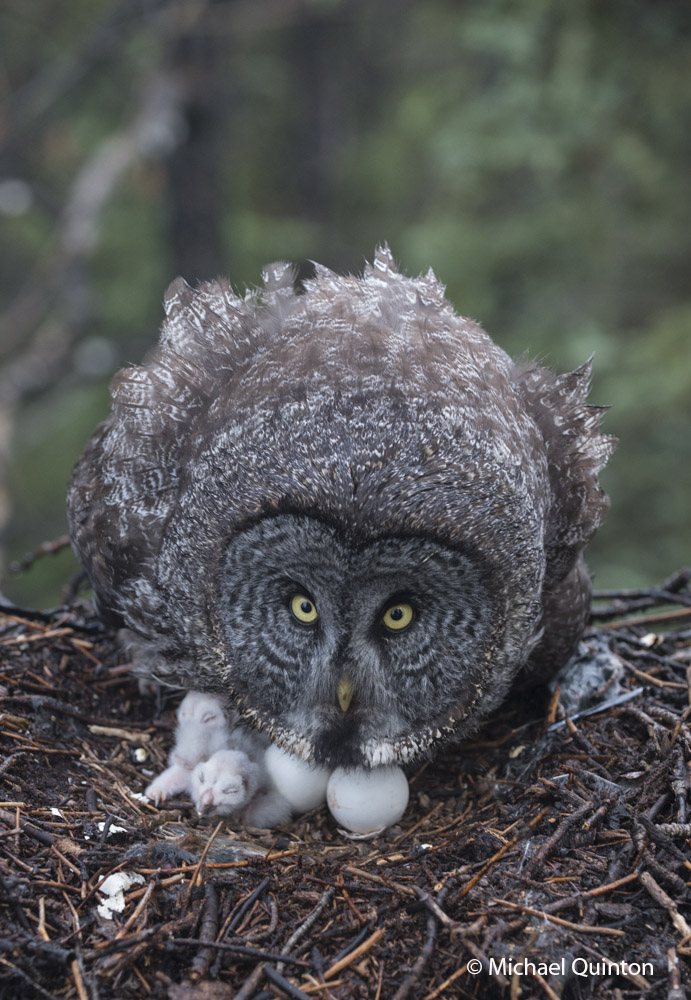 As the female raises up from her brooding, she gives me my first look at the tiny owlets.
As the female raises up from her brooding, she gives me my first look at the tiny owlets.
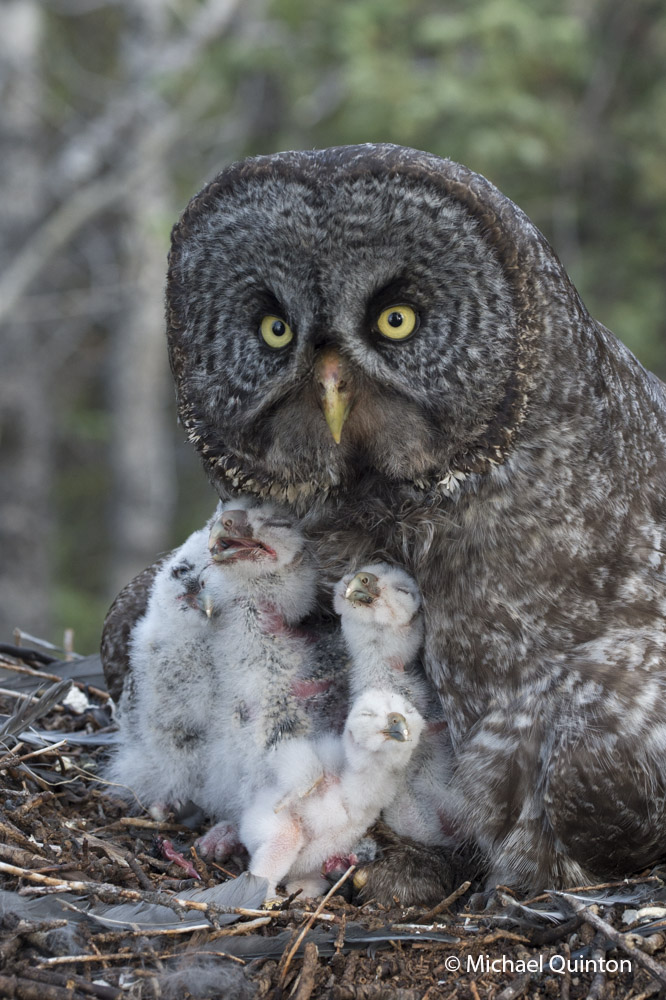 The owlets hatching over a period of about a week account for their age and size difference. Competition among the owls for food favors the older owlets. The smallest owlet, here just a couple of days old, could not hold its own and one morning it was gone.
The owlets hatching over a period of about a week account for their age and size difference. Competition among the owls for food favors the older owlets. The smallest owlet, here just a couple of days old, could not hold its own and one morning it was gone.
https://youtu.be/gG-pWZZjKt4
Watch video of male delivering a red-backed vole. (above)
After a couple of weeks there is no longer a need for constant brooding and the female finally gets a little time to herself. But even then she stays close and alert for danger. One day a pair of ravens hung around the nest in an attempt to harass her from the nest long enough to steal a chick. She held tight and her mate arrived to chase the ravens about. Eventually the ravens left.
 As the female perched near the nest her mate arrives with prey and she follows him in.
As the female perched near the nest her mate arrives with prey and she follows him in.
Arriving at the nest the female takes possession of the red-backed vole from her mate. (right) After a brief pause at the nest the male is off again to continue hunting. (below)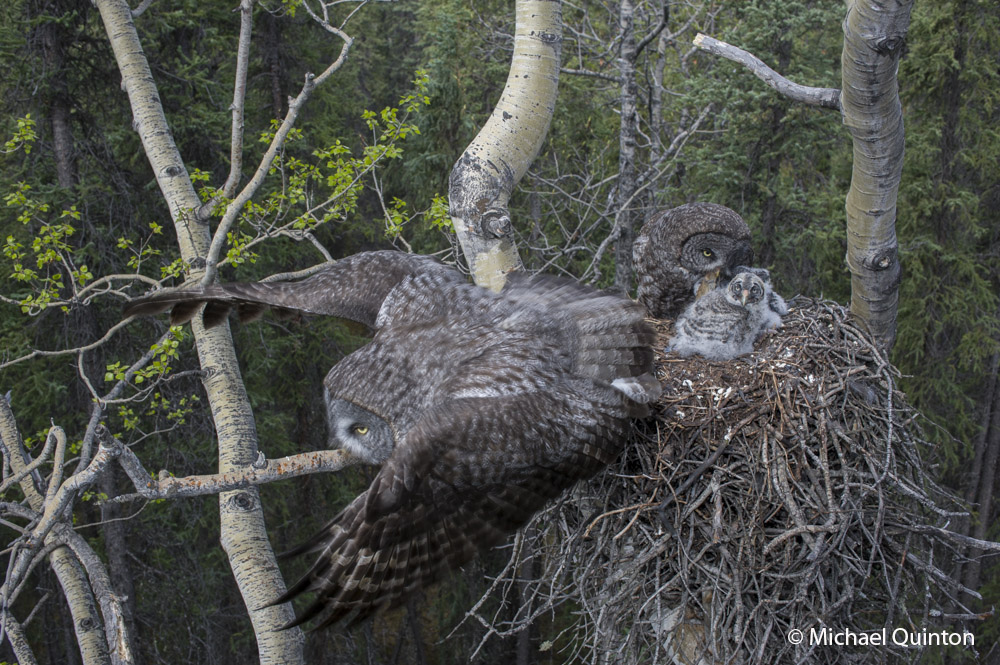
Visit next week for the final post in this series, SECRET LIFE OF A FOREST HUNTER-PART THREE
For the past six weeks or so we have been delighted by the nocturnal trilling song of a little boreal owl. I believe the male has claimed our little forested yard as his own. He sings almost every night from one of the old northern flicker cavities in the black spruce stand surrounding our home. With his little round head filling up the hole he serenades the darkness, or sometimes accompanies the glow and flicker of the aurora.
Click on the left side of the audio bar to hear the song of the boreal owl.
The boreal owl is a nocturnal hunter of voles, shrews, flying squirrels and small birds.
 A northern hawk owl perched atop a dead, black spruce overlooking its preferred hunting grounds, an Alaskan muskeg wetland.
A northern hawk owl perched atop a dead, black spruce overlooking its preferred hunting grounds, an Alaskan muskeg wetland.
The northern hawk owl is named after its hawk-like hunting behavior. Like hawks, the hawk owl hunts by day using its keen eyesight to spot small birds and mammals. The red-backed vole is by far the most important prey species. But the hawk owl is an opportunist and other species of voles and several species of shrews are also caught. During those years when snowshoe hares are plentiful, hawk owls will add these much larger prey species to their list, as will many species of birds from the tiny, common red-poll to birds up to the size of ptarmigan. Continue reading
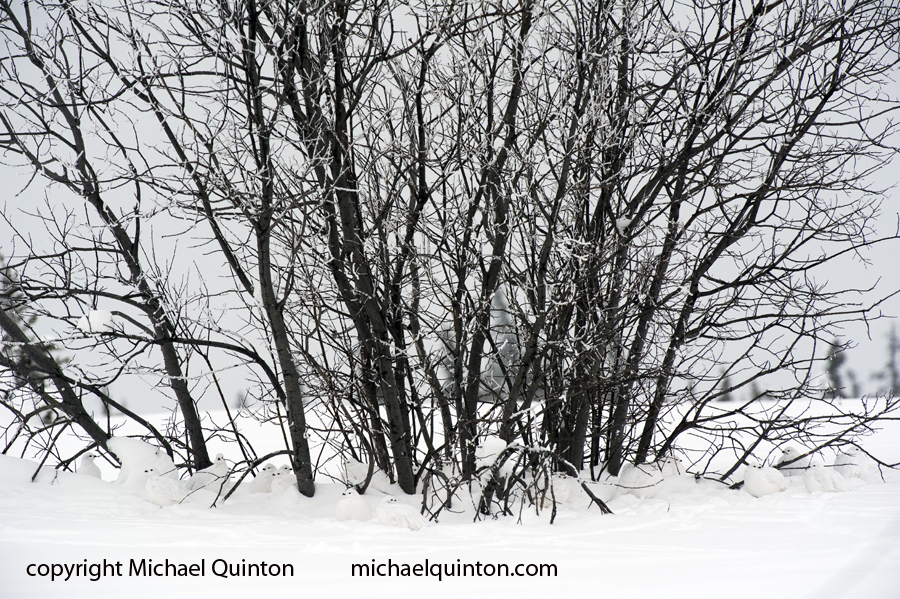 A group of willow ptarmigan huddle beneath a willow in Alaska.
A group of willow ptarmigan huddle beneath a willow in Alaska.
It seems hiding in plain sight would be risky business in our hostile and unforgiving world. But few strategies for survival are as effective as camouflage. Countless species of wildlife including birds, mammals, reptiles, fish, insects have adapted diverse methods of camouflage for offense as well as defense. Continue reading